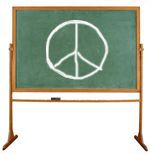
TEACHING PEACE!
The three fundamental elements to teaching peace are teaching tolerance, teaching conflict resolution and teaching the history of peace (peace heroes).
TOLERANCE
We share one world. We must teach that diversity is a strength and recognize that bigotry, insensitivity and ignorance can turn that diversity into a source of prejudice and discrimination.
We must learn to have respect for people whose abilities, beliefs, culture, race or other characteristics that are different from our own. Respect comes from theknowledge and the understanding of the
multitude of characteristics that all humans have in common.
CONFLICT RESOLUTION
As complex as international conflict resolution may appear, teaching basic conflict resolution to young people is pivotal to solving greater problems in the world. Skills such as active listening,
impulse control, empathy, anger management and the appreciation of differences between people and groups must become part of every schools curriculum.
Offensive remarks in school cause hurt and conflict. The National Education Service promotes role-play for students to understand the ramifications of offensive activity in the schools and their
community. Standing-up and supporting the victim is the key to finding support when you yourself are attacked by offensive activities. By improving communication skills and problem-solving abilities
we can create safety, justice and a sense of community.
PEACE HISTORY
Curricular materials in schools focus primarily on war rather than on peace and peacemakers. Peace surveys have demonstrated that students recognize the names of generals but it is rare that students
know the names of peacemakers with comparable accomplishments. Young people are taught more about the history of wars--more about the Bataan death march of WWII than peacemaker Gandhi's salt march,
more about organized hate (e.g., the Nazis) than organized cooperation (e.g., the Peace Corps).
Our history schoolbooks focus on the history of conquerors, slayers of vast numbers of humanity, from Alexander the Great to William the Conqueror to Balboa and Cortez. Little attention is made to
the plight of the defeated--they disappear.
Educators must overcome the view of the state of the world that is propagated by news of violence so savored by the media and by history emphasizing battles and wars. Surrounded by images of violence
in the mass media, in films, video games, books and magazines, it is not surprising that children view violence and warfare as exciting and courageous.
Most people have been totally unaware of the history of non-violent peace movements. There have always been people striving for peace who have opposed war on religious, moral or rational grounds..
Peace is not news but war is headline news--connoting that war is the normal state of affairs. This simple truth is an element of encouragement for those who struggle for peace, but it makes teaching
about peace a difficult task.
It is through challenging existing curriculum in our schools that we will begin to work toward a more peaceful future.
thinkPEACE
For teaching tolerance information and materials, the following website is excellent:
http://www.tolerance.org
For peace education information and materials, go to the United Nations Cyber School Bus
http://www.un.org/cyberschoolbus/
Nobel Peace Prize Winners
Inspirational website includes biographies and information about each peace prize winner.
http://almaz.com/nobel/peace/peace.html
Please let us know if you have any materials already developed in the areas of teaching peace, conflict resolution and teaching tolerence.
"How far you go in life depends on your being tender with the young,
compassionate with the aged, sympathetic with the striving, and tolerant of
the weak and strong. Because someday in your life, you will have been all of these."
--George Washington Carver

